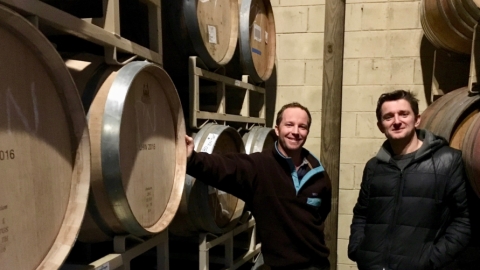Bountiful Shares: Innovative Wineries Use Backyard Vineyards
Flip through any real estate magazine and you’re sure to find glamorous photo spreads of luxury homes surrounded by estate vineyards. Who can afford that?
Maybe not the homeowner. In the Bay Area, local wineries have made a practice of tapping residential properties to plant vineyards that are decorative—and productive—for both the homeowner and the winery.
As a landscaping option, vines are drought tolerant and create an attractive landscape. “It takes a lot less water to do a vineyard than a lawn,” says Dane Stark, second-generation winemaker and owner of Page Mill Winery, founded by his father in Los Altos Hills in 1976 and relocated to Livermore in 2004.
A sun-drenched day in May found Stark shoot-thinning on his winery estate. They make 5,000 cases a year, about 40% from 18 vineyard clients on the Peninsula and in Livermore.
Although each partnership is different, the basic formula is this: The winery does the work, returns some percentage of the produced wine case-yield to the homeowner and is free to sell the rest under its label.
Motivations vary for homeowners who agree to these backyard vineyards. David Page, owner and GM of La Honda Winery in Redwood City, sees a few drivers. “Of course many people just want killer wine,” he says. But others are more interested in creating a beautiful aesthetic, building their dream estate or making an investment. “Some of our clients don’t even drink.”
With the Bay Area daytime heat and night-time cool, residential vineyards can yield high-quality grapes across the varietal spectrum. “It’s no surprise that home vineyards in this area are growing killer grapes,” says Page, who manages more than 50 residential vineyards.
La Honda Winery takes tremendous pride in creating great wine. The team, including winemaker Colin McNany—“a true rising star”—has garnered accolades from the San Francisco Chronicle (double gold and best of class), multiple 90-point marks from Wine Enthusiast and several medals from the California State Fair and Tasters Guild, just in the past few years.
“Winemaking starts in the vineyard and we do a kick-ass job in the vineyard,” says Page, who makes wine almost exclusively from residential vineyards. “People pay us to manage the vineyard, so all our vineyards are in tip-top shape. That’s a rarity in the wine business.”
Local Wine: Did You Know?
The Vitis californica vines were so abundant in west and south Santa Clara Valley that much of the area was called “Uvas,” the Spanish word for grapes.
Source: History of Winemaking in Santa Clara County by Karen Apland
In 1899, a forest fire ravaged the Santa Cruz Mountains, threatening the Mare Vista Winery. When the water supply was lost, winery owner Emil Meyer ordered fire-fighters to use his wine to put out the fire and the winery was saved. After the fire, Los Gatos Creek ran red with claret, surprising residents with a “river of blood.”
Source: Santa Cruz Public Libraries: A History of Wine Making in the Santa Cruz Mountains
After the 1989 Loma Prieta Earthquake, several winemakers blended their surviving barrels into a wine called “Epicenter.” They donated the revenues from this effort to help those affected by the earthquake.
Source: CalWineries.com: Santa Cruz Mountains Wine History


